科斯企业的性质1
- 格式:ppt
- 大小:387.50 KB
- 文档页数:17

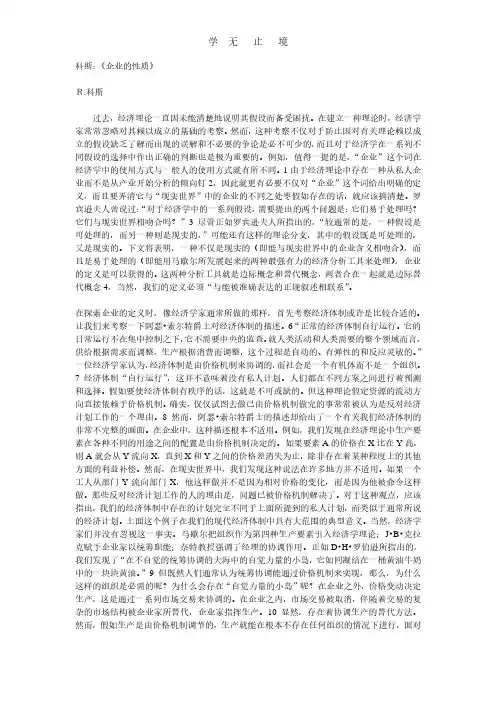
科斯:《企业的性质》R.科斯过去,经济理论一直因未能清楚地说明其假设而备受困扰。
在建立一种理论时,经济学家常常忽略对其赖以成立的基础的考察。
然而,这种考察不仅对于防止因对有关理论赖以成立的假设缺乏了解而出现的误解和不必要的争论是必不可少的,而且对于经济学在一系列不同假设的选择中作出正确的判断也是极为重要的。
例如,值得一提的是,“企业”这个词在经济学中的使用方式与一般人的使用方式就有所不同。
1由于经济理论中存在一种从私人企业而不是从产业开始分析的倾向钉2,因此就更有必要不仅对“企业”这个词给出明确的定义,而且要弄清它与“现实世界”中的企业的不同之处枣假如存在的话,就应该搞清楚。
罗宾逊夫人曾说过:“对于经济学中的一系列假设,需要提出的两个问题是:它们易于处理吗?它们与现实世界相吻合吗?”3尽管正如罗宾逊夫人所指出的,“较通常的是,一种假设是可处理的,而另一种则是现实的,”可能还有这样的理论分支,其中的假设既是可处理的,又是现实的。
下文将表明,一种不仅是现实的(即能与现实世界中的企业含义相吻合),而且是易于处理的(即能用马歇尔所发展起来的两种最强有力的经济分析工具来处理),企业的定义是可以获得的。
这两种分析工具就是边际概念和替代概念,两者合在一起就是边际替代概念4,当然,我们的定义必须“与能被准确表达的正规叙述相联系”。
在探索企业的定义时,像经济学家通常所做的那样,首先考察经济体制或许是比较合适的。
让我们来考察一下阿瑟•索尔特爵土对经济体制的描述。
6“正常的经济体制自行运行。
它的日常运行不在集中控制之下,它不需要中央的监查。
就人类活动和人类需要的整个领域而言,供给根据需求而调整,生产根据消费而调整,这个过程是自动的、有弹性的和反应灵敏的。
”一位经济学家认为,经济体制是由价格机制来协调的,而社会是一个有机体而不是一个组织。
7经济体制“自行运行”,这并不意味着没有私人计划。
人们都在不同方案之间进行着预测和选择。
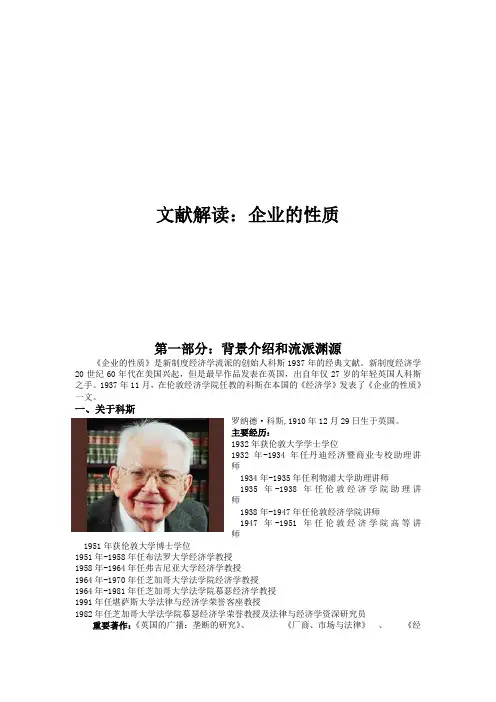
文献解读:企业的性质第一部分:背景介绍和流派渊源《企业的性质》是新制度经济学流派的创始人科斯1937年的经典文献。
新制度经济学20世纪60年代在美国兴起,但是最早作品发表在英国,出自年仅27岁的年轻英国人科斯之手。
1937年11月,在伦敦经济学院任教的科斯在本国的《经济学》发表了《企业的性质》一文。
一、关于科斯罗纳德·科斯,1910年12月29日生于英国。
主要经历:1932年获伦敦大学学士学位1932年-1934年任丹迪经济暨商业专校助理讲师1934年-1935年任利物浦大学助理讲师1935年-1938年任伦敦经济学院助理讲师1938年-1947年任伦敦经济学院讲师1947年-1951年任伦敦经济学院高等讲师1951年获伦敦大学博士学位1951年-1958年任布法罗大学经济学教授1958年-1964年任弗吉尼亚大学经济学教授1964年-1970年任芝加哥大学法学院经济学教授1964年-1981年任芝加哥大学法学院慕瑟经济学教授1991年任堪萨斯大学法律与经济学荣誉客座教授1982年任芝加哥大学法学院慕瑟经济学荣誉教授及法律与经济学资深研究员重要著作:《英国的广播:垄断的研究》、《厂商、市场与法律》、《经济学与经济学家论文集》阳光从未停止照耀——科斯1937年,27岁的科斯当时还默默无闻,他完成了一篇名为《企业的性质》的文章,在被好几家杂志拒绝以后,最后终于发表在伦敦经济学院《经济学家》杂志,起先并没有人注意到这篇文章,直到20多年后科斯的另一篇重要论文《社会成本问题》问世后,《企业的性质》才引起经济学界的高度评价,这篇被埋没20年的文章今天被看作是新制度经济学开始的标志。
由于他揭示并澄清了经济制度结构和函数中交易费用的重要性,1991年获得诺贝尔经济学奖。
这位老人已是年逾花甲,不过当他回忆起自己的往事,他在获奖时无比欣慰的说:“当年我只有21岁,阳光从未停止照耀。
”对于这位白发苍苍的这位老人来说,80岁时对他在20岁做的工作加以褒奖,实在是一种奇特的经历。
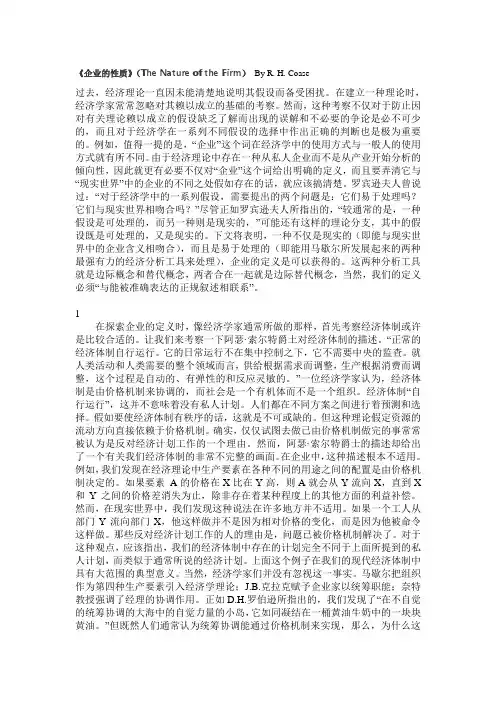
《企业的性质》(The Nature of the Firm)By R. H. Coase过去,经济理论一直因未能清楚地说明其假设而备受困扰。
在建立一种理论时,经济学家常常忽略对其赖以成立的基础的考察。
然而,这种考察不仅对于防止因对有关理论赖以成立的假设缺乏了解而出现的误解和不必要的争论是必不可少的,而且对于经济学在一系列不同假设的选择中作出正确的判断也是极为重要的。
例如,值得一提的是,“企业”这个词在经济学中的使用方式与一般人的使用方式就有所不同。
由于经济理论中存在一种从私人企业而不是从产业开始分析的倾向性,因此就更有必要不仅对“企业”这个词给出明确的定义,而且要弄清它与“现实世界”中的企业的不同之处假如存在的话,就应该搞清楚。
罗宾逊夫人曾说过:“对于经济学中的一系列假设,需要提出的两个问题是:它们易于处理吗?它们与现实世界相吻合吗?”尽管正如罗宾逊夫人所指出的,“较通常的是,一种假设是可处理的,而另一种则是现实的,”可能还有这样的理论分支,其中的假设既是可处理的,又是现实的。
下文将表明,一种不仅是现实的(即能与现实世界中的企业含义相吻合),而且是易于处理的(即能用马歇尔所发展起来的两种最强有力的经济分析工具来处理),企业的定义是可以获得的。
这两种分析工具就是边际概念和替代概念,两者合在一起就是边际替代概念,当然,我们的定义必须“与能被准确表达的正规叙述相联系”。
1在探索企业的定义时,像经济学家通常所做的那样,首先考察经济体制或许是比较合适的。
让我们来考察一下阿瑟·索尔特爵土对经济体制的描述。
“正常的经济体制自行运行。
它的日常运行不在集中控制之下,它不需要中央的监查。
就人类活动和人类需要的整个领域而言,供给根据需求而调整,生产根据消费而调整,这个过程是自动的、有弹性的和反应灵敏的。
”一位经济学家认为,经济体制是由价格机制来协调的,而社会是一个有机体而不是一个组织。
经济体制“自行运行”,这并不意味着没有私人计划。
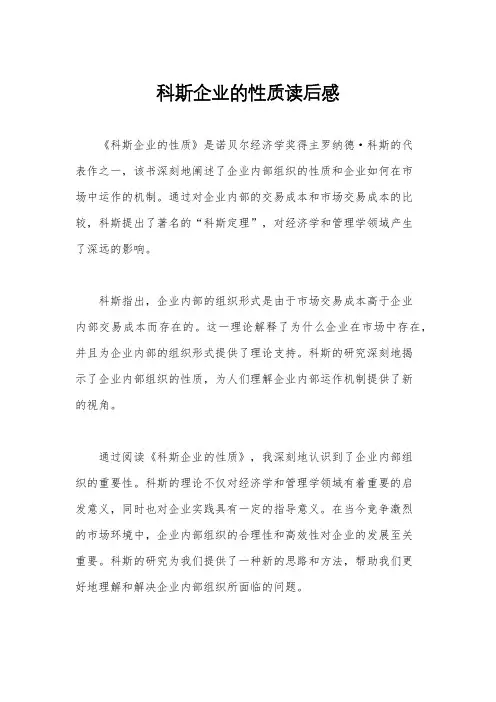
科斯企业的性质读后感《科斯企业的性质》是诺贝尔经济学奖得主罗纳德·科斯的代表作之一,该书深刻地阐述了企业内部组织的性质和企业如何在市场中运作的机制。
通过对企业内部的交易成本和市场交易成本的比较,科斯提出了著名的“科斯定理”,对经济学和管理学领域产生了深远的影响。
科斯指出,企业内部的组织形式是由于市场交易成本高于企业内部交易成本而存在的。
这一理论解释了为什么企业在市场中存在,并且为企业内部的组织形式提供了理论支持。
科斯的研究深刻地揭示了企业内部组织的性质,为人们理解企业内部运作机制提供了新的视角。
通过阅读《科斯企业的性质》,我深刻地认识到了企业内部组织的重要性。
科斯的理论不仅对经济学和管理学领域有着重要的启发意义,同时也对企业实践具有一定的指导意义。
在当今竞争激烈的市场环境中,企业内部组织的合理性和高效性对企业的发展至关重要。
科斯的研究为我们提供了一种新的思路和方法,帮助我们更好地理解和解决企业内部组织所面临的问题。
除此之外,科斯的研究也引发了我对企业内部组织形式的思考。
在现代企业管理中,企业内部组织形式的选择对企业的发展至关重要。
科斯的研究为我们提供了一种新的思路和方法,帮助我们更好地理解和解决企业内部组织所面临的问题。
通过对科斯的研究,我深刻地认识到了企业内部组织形式的重要性,也更加清晰地认识到了企业内部组织形式的选择对企业的发展具有重要的影响。
总的来说,科斯的研究为我们提供了一种新的思路和方法,帮助我们更好地理解和解决企业内部组织所面临的问题。
通过对科斯的研究,我深刻地认识到了企业内部组织形式的重要性,也更加清晰地认识到了企业内部组织形式的选择对企业的发展具有重要的影响。
科斯的研究为我们提供了一种新的思路和方法,帮助我们更好地理解和解决企业内部组织所面临的问题。
通过对科斯的研究,我深刻地认识到了企业内部组织形式的重要性,也更加清晰地认识到了企业内部组织形式的选择对企业的发展具有重要的影响。

The Nature of the Firm (1937)R. H. COASEEconomic theory has suffered in the past from a failure to state clearly its assumption. Economists in building up a theory have often omitted to examine the foundations on which it was erected. This examination is, however, essential not only to prevent them is understanding and needles controversy which arise from a lack of knowledge of the assumptions on which a theory is based, but also because of the extreme importance for economics of good judgment in choosing between rival sets of assumptions. For instance, itis suggested that the use of the word “firm” in economics may be different from the use of the term by the “plain man.”' Since there is apparently a trend in economic theory towards starting analysis with the individual firm and not with the industry,2 it is ail the more necessary not only that a clear definition of the word "firm" should be given but that its difference from a firm in the "real world," if it aists, should be made clear. Mrs. Robinson has said that "the two questions to be asked of a set of assumptions in economics are: Are they tractable? And : Do they correspond with the real world?"3 Though, as Mrs. Robinson points out, "More often one set will be manageable and the other realistic," yet there may well be branches of theory where assumptions may be both manageable and realistic. It is hoped to show in the following paper that a definition of a firm may be obtained which is not only realistic in that it corresponds to what is meant by a firm in the real world, but is tractable by two of the most powerful instruments of economic analysis developed by Marshall, the idea of the margin and that of substitution, together giving the idea of substitution at the margin.4 Our definition must, of course, "relate to formal relations which are capable of being conceived exactly."5IIt is convenient if, in searching for a definition of a firm, we first consider the economic system as it is normally treated by the economist. Let us consider the description of the economic system given by Sir Arthur Salter6. “The normal economic system works itself. For its current operation it is under no central control, it needs no central survey. Over the whole range of human activity and human need, supply is adjusted to demand, andproduction to consumption, by a process that is automatic, elastic and responsive.” An economist thinks of the economic system as being co-ordinated by the price mechanism and society becomes not an organization but an organism.7 The econ omic system “works itself. This does not mean that there is no planning by individuals. These exercise foresight and choose between alternatives. This is necessarily so if there is to be order in the systemBut this theory assumes that the direction of resources is dependent directly on the price mechanism. Indeed, it is often considered to be an objection to economic planning that it merely tries to do what is already done by the price mechanism.8 Sir Arthur Salter's description, however, gives a very incomplete picture of our economic system. Within a firm, the description does not fit at all. For instance, in economic theory we find that the allocation of factors of production between different uses is determined by the price mechanism. The price of factor A becomes higher in X than in Y. As a result, A moves from Y to X until the difference between the prices in X and Y, except if 50 far as it compensates for other differential advantages, disappears. Yet in the real world, we find that there are many areas where this does not apply. If a workman moves from department Y to department X, he does not go because of a change in relative prices, but because he is ordered to do 50. Those who object to economic planning on the grounds that the problem is solved by price movements can be answered by pointing out that there is planning within our economic system which is quite different from the individual planning mentioned above and which is akin to what is normally called economic planning. The example given above is typical of a large sphere in our modem economic system. 0f course, this fact has not been ignored by economists. Marshall introduces organization as a fourth factor of production; J.B. Clark gives theco-ordinating function to the entrepreneur; Professor Knight introduces managers who co-ordinate. As D.H. Robertson points out, we find "islands of conscious power in this ocean of unconscious co-operation like lumps of butter coagulating in a pail of buttermilk.”9 But in view of the fact that it is usua lly argued that co-ordination will be done by the price mechanism, why is such organization necessary? Why are there these "islands of conscious power"? Outside the firm, price movements direct production, which is coordinated through a series of exchange transactions on the market. Within a firm, these markets transactions are eliminated and in place of the complicated market structure with exchange transactions is substituted the entrepreneur co-ordinator, who directs production.10 It is clear that these are alternative methods of co-ordinating production. Yet, having regard to the fact that if production isregulated by price movements, production could be carried on without any organization at all, well might we ask, why is there any organization?0f course, the degree to which the price mechanism is superseded varies greatly. In a department store, the allocation of the different sections to the various locations in the building may be done by the controlling authority or it may be the result of competitive price bidding for space. In the Lancashire cotton industry, a weaver can rent power and shop-room and can obtain looms and yarn on credit.11 This co-ordination of the various factors of production is, however, normally carried out without the interven tion of the price mechanism. As is evident, the amount of “vertical” integration, involving as it does the supersession of the price mechanism, varies greatly from industry to industry and from firm to firm. It can, I think, be assumed that the distinguishing mark of the firm is the supersession of the price mechanism. It is, of course, as Professor Robbins points out, “related to an outside network of relative prices and costs,” 12 but it is important to discover the exact nature of this relationship. This distinction between the allocation of resources in a firm and the allocation in the economic system has been very vividly described by Mr. Maurice Dobb when discussing Adam Smith's conception of the capitalist: “It began to be seen that there was something more important than the relations inside each factory or unit captained by an undertaker; there were the relations of the undertaker with the rest of the economic world outside his immediate sphere... the undertaker busies himself with the division of labour inside each firm and he plans and organises consciously,” but “he is related to the much larger economic specialisation, of which he himself is merely one specialised unit. Here, he plays his part as a single ceIl in a larger organism, mainly unconscious of the wider rôle he fills.”13In view of the fact that while economists treat the price mechanism as a coordinating instrument, the? also admit the co-ordinating function of the “entrepreneur,” it is surely important to enquire whyco-ordination is the work of the price mechanism in one case and of the entrepreneur in another. The purpose of this paper is to bridge what appears to be a gap in economic theory between the assumption (made for some purposes) that resources are allocated by means of the price mechanism and the assumption (made for other purposes) that this allocation is dependent on the entrepreneur-co-ordinator. We have to explain the basis on which, in practice, this choice between alternatives is effected.14IIOur task is to attempt to discover why a firm emerges at ah in a specialized exchange economy. The price mechanism (considered purely from the side of the direction of resources) might be superseded if the relationship which replaced it was desired for its own sake. This would be the case, for example, if some people preferred to work under the direction of some other person. Such individuals would accept less in order to work under someone, and firms would arise naturally from this. But it would appear that this cannot be a very important reason, for it would rather seem that the opposite tendency is operating if one judges from the stress normally laid on the advantage of “being one's own master;”15 0f course, if the desire was not to be controlled but to control, to exercise power over others, then people might be willing to give Up something in order to direct others; that is, they would be willing to pay others more than they could get under the price mechanism in order to be able to direct them. But this implies that those who direct pay in order to be able to do this and are not paid to direct, which is clearly not true in the majority of cases.16 Firms might also exist if purchasers preferred commodities which are produced by firms to those not 50 produced; but even in spheres where one would expect such preferences (if they exist) to be of negligible importance, firms are to be found in the real world.17 Thereforethere must be other elements involved.The main reason why it is profitable to establish a firm would seem to be that there is a cost of using the price mechanism. The most obvious cost of “organizing” production through the price mechanism is that of discovering what the relevant prices are.18 This cost may be reduced but it will not be eliminated by the emergence of specialists who will sell this information. The costs of negotiating and concluding a separate contract for each exchange transaction which takes place on a market must also be taken into account.19 Again, in certain markets, e.g., produce ex-changes, a technique is devised for minimizing these contract costs; but they are not eliminated. It is true that contracts are not eliminated when there is a firm but they are greatly reduced. A factor of production (or the owner thereof) does not have to make a series of contracts with the factors with whom he is co-operating within the firm, as would be necessary, of course, if this co-operation were as a direct result of the working of the price mechanism. For this series of contracts is substituted one. At this stage, it is important to note the character of the contract into which a factor enters that is employed within a firm. The contract is one whereby the factor, for a certain remuneration (which may be fixed or fluctuating), agrees to obey the directions of an entrepreneur within certain limits.20 The essence of the contract is that it should only state the limits to the powers of the entrepreneur; Within these limits, he can therefore direct the other factors of production.There are, however, other disadvantages - or costs - of using the price mechanism. It may be desired tomake a long-term contract for the supply of some article or service. This may be due to the fact that if one contract is made for a longer period, instead of several shorter ones, then certain costs of making each contract will be avoided. Or, owing to the risk attitude of the people concerned, they may prefer to make a long rather than a short-term contract. Now, owing to the difficulty of forecasting, the longer the period of the contract is for the supply of the commodity or service, the less possible, and indeed, the less desirable it is for the person purchasing to specify what the other contracting party is expected to do. It may well be a matter of indifference to the person supplying the service or commodity which of several courses of action is taken, but not to the purchaser of that service or commodity. But the purchaser will not know which of these several courses he will want the supplier to take. Therefore, the service which is being provided is expressed in general terms, the exact details being left until a later date. All that is stated in the contract is the limits to what the persons supplying the commodity or service is expected to do. The details of what the supplier is expected to do is not stated in the contract but is decided later by the purchaser. When the direction of resources (within the limits of the contract) becomes dependent on the buyer in this way, that relationship which I term a "firm" may be obtained.21 A firm is likely therefore to emerge in those cases where a very short-term contract would be unsatisfactory. It is obviously of more importance in the case of services -labor-than it is in the case of the buying of commodities. In the case of commodities, the main items can be stated in advance and the details which will be decided later will be of minor significance.We may sum Up this section of the argument by saying that the operation of a market costs something and by forming an organization and allowing some authority (an "entrepreneur") to direct the resources, certain marketing costs are saved. The entrepreneur has to carry out his function at less cost, taking into account the fact that he may get factors of production at a lower price than the market transactions which he supersedes, because it is always possible to revert to the open market if he fails to do this. The question of uncertainty is one which is often considered to be very relevant to the study of the equilibrium of the firm. It seems improbable that a firm would emerge without the existence of uncertainty. But those, for instance, Professor Knight, who make the mode of payment the distinguishing mark of the firm - fixed incomes being guaranteed to some of those engaged in production by a person who takes the residual, and fluctuating, income-would appear to be introducing a point which is irrelevant to the problem we are considering. One entrepreneur may sell his services to another for a certain sum of money, while the payment to his employees may be mainly or wholly a share in profits.22 Thesignificant question would appear to be why the allocation of resources is not done directly by the price mechanism.Another factor that should be noted is that exchange transactions on a market and the same transactions organized within a firm are often treated differently by Governments or other bodies with regulatory powers. If we consider the operation of a sales tax, it is clear that it is a tax on market transactions and not on the same transactions organized within the firm. Now since these are alternative methods of organization"-by the price mechanism or by the entrepreneur-such a regulation would bring into existence firms which otherwise would have no raison d'être. It would furnish a reason for the emergence of a firm in a specialized exchange economy. 0f course, to the extent that firms already exist, such a measure as a sales tax would merely tend to make them larger than they would otherwise be. Similarly, quota schemes, and methods of price control which imply that there is rationing, and which do not apply to firms producing such products for themselves, by allowing advantages to those who organize within the firm and flot through the market, necessarily encourage the growth of firms. But it is difficult to believe that it is measures such as have been mentioned in this paragraph which have brought firms into existence. Such measures would, however, tend to have this result if they did not exist for other reasons.These, then, are the reasons why organizations such as firms exist in a specialized exchange economy in which it is generally assumed that the distribution of resources is "organized" by the price mechanism.A firm, therefore, consists of the system of relationships which comes into existence when the direction of resources is dependent on an entrepreneur; The approach which has just been sketched would appear to offer an advantage in that it is possible to give a scientific meaning to what is meant by saying that a firm gets larger or smaller A firm becomes larger as additional transactions (which could be exchange transactions co-ordinated through the price mechanism) are organized by the entrepreneur and becomes smaller as he abandons the organization of such transactions. The question which arises is whether it is possible to study the forces which determine the size of the firm. Why does the entrepreneur not organize one less transaction or one more? It is interesting to note that Professor Knight considers that:the relation between efficiency and size is one of the most serious problems of theory, being, in contrast with the relation for a plant, largely a matter of personality and historical accident rather than of intelligible general principles.But the question is peculiarly vital because the possibility of monopoly gain offers a powerful incentive to continuous and unlimited expansion of the firm, which force must be offset by some decreased efficiency (in the production of money income) with growth in size, if even boundary competition is toexist.23equally powerful one making forProfessor Knight would appear to consider that it is impossible to treat scientifically the determinants of the size of the firm. On the basis of the concept of the firm developed above, this task will now be attempted.It was suggested that the introduction of the firm was due primarily to the existence of marketing costs. A pertinent question to ask would appear to be (quite apart from the monopoly considerations raised by Professor Knight), why, if by organizing one can eliminate certain costs and in fact reduce the cost of production, are there any market transactions at all?24 Why is not ah production carried on by one big firm? There would appear to be certain possible explanations.First, as a firm gets larger, there may be decreasing returns to the entrepreneur function, that is, the costs of organizing additional transactions within the firm may rise.25 Naturally, a point must be reached where the costs of organizing an extra transaction within the firm are equal to the costs involved in carrying out the transaction in the open market, or; to the costs of organizing by another entrepreneur. Secondly, it may be that as the transactions which are organized increase, the entrepreneur fails to place the factors of production in the uses where their value is greatest, that is, fails to make the best use of the factors of production. Again, a point must be reached where the loss through the waste of resources is equal to the marketing costs of the exchange transaction in the open market or to the loss if the transaction was organized by another entrepreneur. Finally, the supply price of one or more of the factors of production may rise, because the "other advantages" of a small firm are greater than those of a large firm.26 0f course, the actual point where the expansion of the firm ceases might be determined by a combination of the factors mentioned above. The first two reasons given most probably correspond to the economists' phrase of "diminishing returns to management."27The point has been made in the previous paragraph that a firm will tend to expand until the costs of organizing an extra transaction within the firm become equal to the costs of carrying out the same transaction by means of an exchange on the open market or the costs of organizing in another firm. But if the firm stops its expansion at a point below the costs of marketing in the open market and at a point equal to the costs of organizing in another firm, in most cases (excluding the case of "combination"28), this will imply that there is a market transaction between these two procedures, each of whom could organize it at less than the actual marketing costs. How is the paradox to be resolved? If we consider an example the reason for this will become clear. Suppose A is buying a product from B and that both A and B could organize this marketing transaction at less than its present cost. B, we can assume, is not organizing one process or stage of production, but several. If A therefore wishes to avoid a market transaction, he will have to take over all the processes of production controlled by B. Unless A takes over ail the processes of production, a market transaction will still remain, although it is a different product that is bought. But we have previously assumed that as each producer expands he becomes less efficient; the additional costs of organizing extra transactions increase. It is probable that A's cost of organizing the transactions previously organized by B will be greater than B's costs of doing the same thing. A therefore will take over the whole of B's organization only if his cost of organizing B's work is not greater than B's cost by an amount equal to the costs of carrying out an exchange transaction on the open market. But once it becomes economical to have a market transaction, it also pays to divide production in such a way that the cost of organizing an extra transaction in each firm is the same.Up to now it has been assumed that the exchange transactions which take place through the price mechanism are homogeneous. In fact, nothing could be more diverse than the actual transactions which take place in our modem world. This would seem to imply that the costs of carrying out exchange transactions through the price mechanism will vary considerably as will also the costs of organizing these transactions within the firm. It seems therefore possible that quite apart from the question of diminishing returns the costs of organizing certain transactions within the firm may be greater than the costs of carrying out the exchange transactions in the open market. This would necessarily imply that there were exchange transactions carried out through the price mechanism, but would it mean that there would have to be more than one firm? Clearly not, for all those areas in the economicsystem where the direction of resources was not dependent directly on the price mechanism could be organized within one firm. The factors which were discussed earlier would seem to be the important ones, though it is difficult to say whether "diminishing returns to management" or the rising supply price of factors is likely to be the more important.Other things being equal, therefore, a firm will tend to be larger:a. the less the costs of organizing and the slower these costs rise with an increase in the transactions organized.b. the less likely the entrepreneur is to make mistakes and the smaller the increase in mistakes with an increase in the transactions organized.c. the greater the lowering (or the less the rise) in the supply price of factors of production to firms of larger size.Apart from variations in the supply price of factors of production to firms of different sizes, it would appear that the costs of organizing and the losses through mistakes will increase with an increase in the spatial distribution of the transactions organized, in the dissimilarity of the transactions, and in the probability of changes in the relevant prices.29 As more transactions are organized by an entrepreneur, it would appçar that the transactions would tend to be either different in kind or in different places. This furnishes an additional reason why efficiency will tend to decrease as the firm gets larger. Inventions which tend to bring factors of production nearer together, by lessening spatial distribution,tend to increase the size of the firm.30 Changes like the telephone and the telegraph which tend to reduce the cost of organizing spatially will tend to increase the size of the firm. All changes which improve managerial technique will tend to increase the size of the firm.31/32 It should be noted that the definition of a firm which was given above can be used to give more precise meanings to the terms "combination" and "integration."33 There is a combination when transactions which were previously organized by two or more entrepreneurs become organized by one. This becomes integration when it involves the organization of transactions which were previously carried out between the entrepreneurs on a market. A firm can expand in either or both of these two ways. The whole of the "structure of competitive industry" becomes tractable by the ordinary technique ofeconomic analysis.IIIThe problem which has been investigated in the previous section has not been entirely neglected by economists and it is now necessary to consider why the reasons given above for the emergence of a firm in a specialized exchange economy are to be preferred to the other explanations which have been offered. It is sometimes said that the reason for the existence of a firm is to be found in the division of labor This is the view of Professor Usher, a view which has been adopted and expanded by Mr. Maurice Dobb. The firm becomes "the result of an increasing complexity of the division of lab our… The growth of this economic differentiation creates the need for some integrating force without which differentiation would collapse into chaos; and it is as the integrating force in a differentiated economy that industrial forms are chiefly significant."34 The answer to this argument is an obvious one. The "integrating force in a differentiated economy" already exists in the form of the price mechanism. It is perhaps the main achievement of economic science that it has shown that there is no reason to suppose that specialization must lead to chaos.35 The reason given by Mr. Maurice Dobb is therefore inadmissible. What has to be explained is why one integrating force (the entrepreneur) should be substituted for another integrating force (the price mechanism). The most interesting reasons (and probably the most widely accepted) which have beengiven to explain this fact are those to be found in Professor Knight's Risk, Uncertainty and Profit. His views will be examined in some detail.Professor Knight starts with a system in which there is no uncertainty:acting as individuals under absolute freedom but without collusion men are supposed to have organised economic life with the primary and secondary division of labour, the use of capital, etc., developed to the point familiar in present-day America. The principal fact which calls for the exercise of the imagination is the internal organization of the productive groups or establishments. With uncertainty entirely absent, every individual being in possession of perfect knowledge of the situation,there would be no occasion for anything of the nature of responsible management or control of productive activity. Even marketing transactions in any realistic sense would not be found. The flow of raw materials and productive services to the consumer would be entirely automatic.36Professor Knight says that we can imagine this adjustment as being "the result of a long process of experimentation worked out by trial-and-error methods alone," while it is not necessary "to imagine every worker doing exactly the right thing at the right time in a sort of 'pre-established harmony' with the work of others. There might be managers, superintendents, etc., for the purpose of co-ordinating the activities of individuals," though these managers would be performing a purely routine function, "without responsibility of any sort."37Professor Knight then continues:With the introduction of uncertainty-the fact of ignorance and the necessity of acting upon opinion rather than knowledge-into this Eden-like situation, its character is entirely changed. . . .。
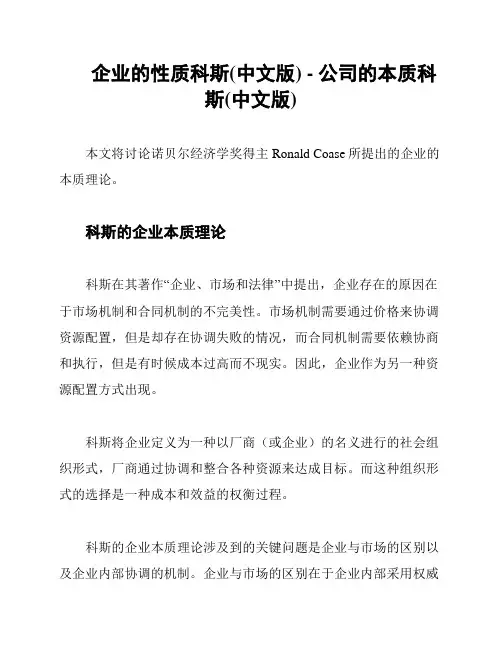
企业的性质科斯(中文版) - 公司的本质科斯(中文版)本文将讨论诺贝尔经济学奖得主Ronald Coase所提出的企业的本质理论。
科斯的企业本质理论科斯在其著作“企业、市场和法律”中提出,企业存在的原因在于市场机制和合同机制的不完美性。
市场机制需要通过价格来协调资源配置,但是却存在协调失败的情况,而合同机制需要依赖协商和执行,但是有时候成本过高而不现实。
因此,企业作为另一种资源配置方式出现。
科斯将企业定义为一种以厂商(或企业)的名义进行的社会组织形式,厂商通过协调和整合各种资源来达成目标。
而这种组织形式的选择是一种成本和效益的权衡过程。
科斯的企业本质理论涉及到的关键问题是企业与市场的区别以及企业内部协调的机制。
企业与市场的区别在于企业内部采用权威关系而非价格机制来协调资源配置。
而企业内部协调的机制则是通过权威关系、规则制度和契约来实现的。
企业内部权威关系所具有的特点是权力的归中和指挥的纵深。
这种权力的归中能够保证企业内部的一致性和整体效率,而指挥的纵深能够保证信息和命令的传递效率。
规则制度在企业内部协调中的作用是在某种程度上取代市场机制,从而实现更好的资源配置。
规则制度的核心是一系列标准化的规章制度和程序。
规则制度的实施要求企业内部各个部门或员工对企业整体目标和规则制度能够进行自觉遵守。
契约在企业内部的协作中同样具有重要作用。
契约可以明确各自的权利和义务,规定合作方式和目标,减少互动成本和风险,提高合作的效率和质量。
但是,契约本身也有其成本,如签订、执行、监督等环节。
小结科斯的企业本质理论反映了企业内部组织和协作的基本特点。
企业作为一种资源配置方式,在协调和整合各种资源的同时,也面临诸多的成本和效益权衡。
同时,企业内部协调也需要靠权威关系、规则制度和契约等手段来实现。
最后,我们需要明确的是,企业内部的效率和一致性并不是无限提高的,而需要针对实际问题进行制度设计和改进。

科斯:企业的性质原著:科斯——陈郁过去,经济理论一直因未能清楚地说明其假设而备受困扰。
在建立一种理论时,经济学家常常忽略对其赖以成立的基础的考察。
然而,这种考察不仅对于防止因对有关理论赖以成立的假设缺乏了解而出现的误解和不必要的争论是必不可少的,而且对于经济学在一系列不同假设的选择中作出正确的判断也是极为重要的。
例如,值得一提的是,“企业”这个词在经济学中的使用方式与一般人的使用方式就有所不同。
1由于经济理论中存在一种从私人企业而不是从产业开始分析的倾向钉2,因此就更有必要不仅对“企业”这个词给出明确的定义,而且要弄清它与“现实世界”中的企业的不同之处棗假如存在的话,就应该搞清楚。
罗宾逊夫人曾说过:“对于经济学中的一系列假设,需要提出的两个问题是:它们易于处理吗?它们与现实世界相吻合吗?”3尽管正如罗宾逊夫人所指出的,“较通常的是,一种假设是可处理的,而另一种则是现实的,”可能还有这样的理论分支,其中的假设既是可处理的,又是现实的。
下文将表明,一种不仅是现实的(即能与现实世界中的企业含义相吻合),而且是易于处理的(即能用马歇尔所发展起来的两种最强有力的经济分析工具来处理),企业的定义是可以获得的。
这两种分析工具就是边际概念和替代概念,两者合在一起就是边际替代概念4,当然,我们的定义必须“与能被准确表达的正规叙述相联系”。
51在探索企业的定义时,像经济学家通常所做的那样,首先考察经济体制或许是比较合适的。
让我们来考察一下阿瑟·索尔特爵土对经济体制的描述。
6“正常的经济体制自行运行。
它的日常运行不在集中控制之下,它不需要中央的监查。
就人类活动和人类需要的整个领域而言,供给根据需求而调整,生产根据消费而调整,这个过程是自动的、有弹性的和反应灵敏的。
”一位经济学家认为,经济体制是由价格机制来协调的,而社会是一个有机体而不是一个组织。
7经济体制“自行运行”,这并不意味着没有私人计划。
人们都在不同方案之间进行着预测和选择。
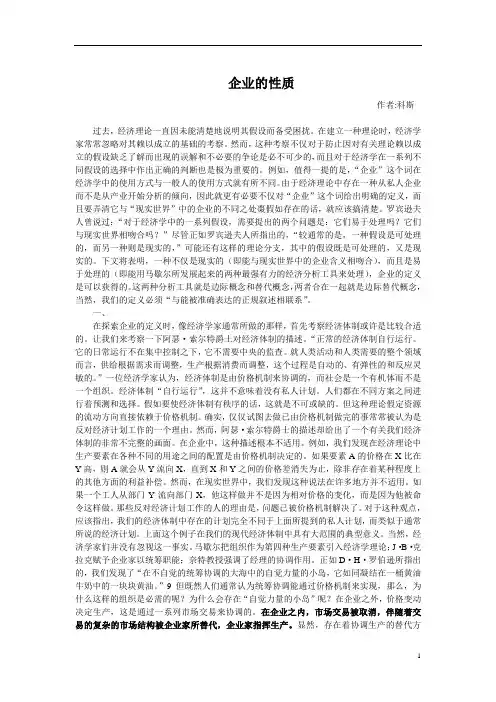
企业的性质作者:科斯过去,经济理论一直因未能清楚地说明其假设而备受困扰。
在建立一种理论时,经济学家常常忽略对其赖以成立的基础的考察。
然而,这种考察不仅对于防止因对有关理论赖以成立的假设缺乏了解而出现的误解和不必要的争论是必不可少的,而且对于经济学在一系列不同假设的选择中作出正确的判断也是极为重要的。
例如,值得一提的是,“企业”这个词在经济学中的使用方式与一般人的使用方式就有所不同。
由于经济理论中存在一种从私人企业而不是从产业开始分析的倾向,因此就更有必要不仅对“企业”这个词给出明确的定义,而且要弄清它与“现实世界”中的企业的不同之处棗假如存在的话,就应该搞清楚。
罗宾逊夫人曾说过:“对于经济学中的一系列假设,需要提出的两个问题是:它们易于处理吗?它们与现实世界相吻合吗?”尽管正如罗宾逊夫人所指出的,“较通常的是,一种假设是可处理的,而另一种则是现实的,”可能还有这样的理论分支,其中的假设既是可处理的,又是现实的。
下文将表明,一种不仅是现实的(即能与现实世界中的企业含义相吻合),而且是易于处理的(即能用马歇尔所发展起来的两种最强有力的经济分析工具来处理),企业的定义是可以获得的。
这两种分析工具就是边际概念和替代概念,两者合在一起就是边际替代概念,当然,我们的定义必须“与能被准确表达的正规叙述相联系”。
一、在探索企业的定义时,像经济学家通常所做的那样,首先考察经济体制或许是比较合适的。
让我们来考察一下阿瑟·索尔特爵土对经济体制的描述。
“正常的经济体制自行运行。
它的日常运行不在集中控制之下,它不需要中央的监查。
就人类活动和人类需要的整个领域而言,供给根据需求而调整,生产根据消费而调整,这个过程是自动的、有弹性的和反应灵敏的。
”一位经济学家认为,经济体制是由价格机制来协调的,而社会是一个有机体而不是一个组织。
经济体制“自行运行”,这并不意味着没有私人计划。
人们都在不同方案之间进行着预测和选择。
假如要使经济体制有秩序的话,这就是不可或缺的。
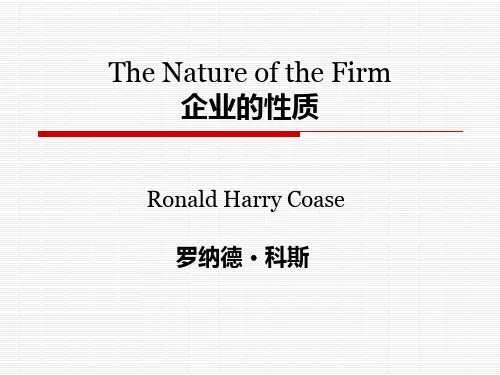
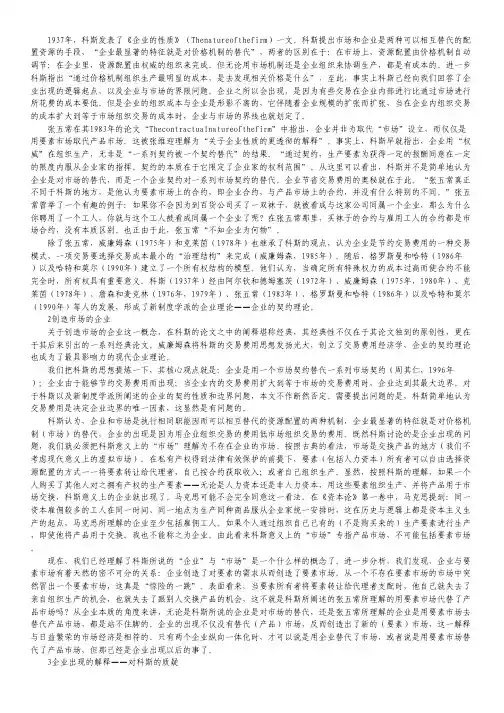
1937年,科斯发表了《企业的性质》(Thenatureofthefirm)一文。
科斯提出市场和企业是两种可以相互替代的配置资源的手段,“企业最显著的特征就是对价格机制的替代”,两者的区别在于:在市场上,资源配置由价格机制自动调节;在企业里,资源配置由权威的组织来完成。
但无论用市场机制还是企业组织来协调生产,都是有成本的。
进一步科斯指出“通过价格机制组织生产最明显的成本,是去发现相关价格是什么”,至此,事实上科斯己经向我们回答了企业出现的逻辑起点,以及企业与市场的界限问题。
企业之所以会出现,是因为有些交易在企业内部进行比通过市场进行所花费的成本要低。
但是企业的组织成本与企业是形影不离的,它伴随着企业规模的扩张而扩张,当在企业内组织交易的成本扩大到等于市场组织交易的成本时,企业与市场的界线也就划定了。
张五常在其1983年的论文“Thecontractualnatureofthefirm”中指出,企业并非为取代“市场”设立,而仅仅是用要素市场取代产品市场。
这被张维迎理解为“关子企业性质的更透彻的解释”。
事实上,科斯早就指出,企业用“权威”在组织生产,无非是“一系列契约被一个契约替代”的结果。
“通过契约,生产要素为获得一定的报酬同意在一定的限度内服从企业家的指挥。
契约的本质在于它限定了企业家的权利范围”。
从这里可以看出,科斯并不是简单地认为企业是对市场的替代,而是一个企业契约对一系列市场契约的替代。
企业节省交易费用的奥秘就在于此。
“张五常真正不同于科斯的地方,是他认为要素市场上的合约,即企业合约,与产品市场上的合约,并没有什么特别的不同。
”张五常曾举了一个有趣的例子:如果你不会因为到百货公司买了一双袜子,就被看成与这家公司同属一个企业,那么为什么你聘用了一个工人,你就与这个工人被看成同属一个企业了呢?在张五常那里,买袜子的合约与雇用工人的合约都是市场合约,没有本质区别。
也正由于此,张五常“不知企业为何物”。
科斯-企业的性质(Coase - the nature of the firm)The essence of enterprise - CoaseIn the past, economic theories have been plagued by the absence of a clear explanation of their assumptions. In the establishment of a theory, economicsIt is often neglected to examine the basis for which it is founded. However, this investigation is not only to prevent from relying on relevant theoriesMisunderstandings and unnecessary arguments arising from a lack of understanding of the hypothesis are essentialIt is also important to make the right judgments in a series of different assumptions. For example, it is worth mentioning that, "enterprise"The word "industry" is different from the way people use it in economics. 1 because of economic theoryIn an analysis of the propensity to start from private enterprises rather than from the industry, 2 is therefore more necessary, not only for enterprises, but also for enterprisesIt gives a clear definition, and the difference between it and the enterprise in the "real world" - if it existsIf you do, you should be clear about it. Mrs. Robinson once said, "a series of assumptions about economics need to be put forwardThe two question is: are they easy to handle? Are they compatible with the real world?" 3, just as Mrs. Robinson pointed outMore often than not, one hypothesis can be dealt with, and the other is realistic, and there may beThe branch of theory, in which the hypothesis is both practical and practical. The following will show that one is not only realisticThat is, it can match the meaning of the enterprise in the real world, and it is easy to handle (that is, it can be developed with MarshallThe two most powerful economic analysis tools to deal with, the definition of the enterprise is available. These two analytical toolsThat is, the concept of margin and the concept of substitution, the 4 together is the concept of marginal substitution, of course, our definition must be"Associated with formal statements that can be accurately expressed"When exploring the definition of an enterprise, as economists usually do, first examine the economic system and perhaps compare itAppropriate。
企业的性质罗纳德·科斯罗纳德·科斯(Ronald Harry Coase,1910-),芝加哥大学经济学教授,高级法与经济学研究员。
美国文理研究院院士,美国经济学会杰出会员。
1991年获诺贝尔经济学奖。
主要作品有《企业的性质》(1937),《社会成本问题》(1960),《经济学中的灯塔》(1974)等。
过去,经济理论一直因未能清楚地说明其假设而备受困扰。
在建立一种理论时,经济学家常常忽略对其赖以成立的基础的考察。
然而,这种考察不仅有利于防止因对有关理论赖以成立的假设缺乏了解而出现的误解和不必要的争论是必不可少的,而且对于经济学在一系列不同假设的选择中作出正确的判断也是极为重要的。
例如,值得一提的是,“企业”一词经济学中的使用方式与一般人的使用方式就有所不同1。
由于经济理论分析总是倾向于以个体企业而非产业为起点2,因而就更有必要不仅对“企业”这个词进行明确的界定,而且要弄清它与“现实世界”中的企业的不同之处,假使存在的话,就也应该搞清楚。
罗宾逊夫人曾说过:“对于经济学中的一系列假设,需要问的两个问题是:它们易于处理吗?它们与现实世界相吻合吗?”3尽管正如罗宾逊夫人所指出的,“较通常的是,一类假设是可处理的,而另一类则是现实的”,然而,可能还有这样的理论分支,其中的假设既是可处理的,又是现实的。
下文将试着证明,同时符合以上两个要求的企业定义是可以实现的,即一方面它不仅是现实的,即能与现实世界中的企业含义相吻合,而且另一方面却又易于处理,能用马歇尔提出的两种最强有力的经济分析工具加以分析。
这两种分析工具就是边际概念和替代概念,两者合在一起就是边际替代概念4。
当然,我们的定义必须还能用于“准确地推想企业的相关关系而不仅仅只是异想天开的臆造”5。
一在探索企业的定义时,像经济学家通常所做的那样,首先考察经济系统或许是比较合适1JoanRobison,Economics is a Serious Subject (1932),p.12.2见N. Kaldor,“The Equilibrium of the Firm”,Economic Journal,March,1934。
企业的性质2008-11-06 17:48:35| 分类:课程教学与交流| 标签:|字号大中小订阅现代制度经济学,在不同的研究视角下,对企业的性质做出了不同的阐述。
科斯认为企业是对市场的一种替代,阿尔齐安和德姆塞茨认为企业的实质是一种团队生产方式,张五常认为企业其实是要素市场对产品市场的取代。
一、科斯:对市场的替代科斯《企业的性质》标志着现代企业理论的诞生,科斯引入了交易费用来解释企业的产生的根本原因。
在《社会成本问题》中,科斯详细阐述了在正交易费用条件下,初始产权的配置与保障成为至关重要的因素,不同的初始产权配置结构,在其后为消除外部影响的权利交易中,形成的交易费用大小并不一样,选择怎样的资源配置方式,应当根据各种权利配置方式可能产生的交易费用的大小来权衡。
在市场上利用价格机制来协调交易活动是有成本的,这种成本就是交易费用。
对于市场交易来说,最重要的成本来源于决定商品或服务价格的成本、谈判和拟定合约的成本以及由信息失灵导致的成本。
正是出于节约交易费用的目的,人们才把某些资源配置活动转到企业内部,由企业家来协调生产。
科斯认为通过企业方式配置资源,在一定的范围内能够起到减少交易费用的作用,为此引进了要素契约的概念。
企业替代市场的经济性就在于企业的“一次性、长期的契约”代替了市场交易各方的“一系列、短期的产品契约”。
“当存在企业时,契约不会被取消,但却大大减少了。
某一生产要素(或它的所有者)不必与企业内部同他合作的一些生产要素签订一系列的契约。
当然,如果这种合作是价格机制起作用的一个直接结果,一系列的契约就是必需的。
一系列的契约被一个契约替代了。
”“如果签订一个较长期的契约以替代若干个较短期的契约,那么,签订每一个契约的部分费用就将被节省下来。
”在此基础上,科斯提出市场和企业是两种不同的资源配置方式,二者具有互替性,市场通过价格机制来调节资源;企业则通过权威来进行调节。
企业的存在是由于它能节约市场的交易成本,所以交易成本的差别是企业出现的真正原因。
企业的性质基于科斯的观点-完整版科斯是20世纪著名的经济学家和社会学家,他的观点在企业性质的研究中具有重要的参考价值。
科斯的研究表明,企业是为了解决市场交易中的交易成本和协调成本而产生的组织形式,而不是为了追求利润最大化而存在的经济实体。
科斯认为,企业性质的核心问题是资源配置的问题,即如何在交易成本和协调成本之间取得平衡。
当市场存在高昂的交易成本和协调成本时,企业就有可能产生。
一方面,企业可以通过内部协调来降低交易成本,另一方面,企业也可以通过内部控制来保证员工的合作和协调,从而降低协调成本。
因此,企业的存在可以看作是一种交易成本和协调成本的权衡。
在科斯看来,企业所面临的关键问题是如何组织生产和分配资源。
根据交易成本和协调成本的不同,企业可以分为不同的性质。
具体而言,科斯提出了三种企业性质,即完全垂直一体化企业、完全水平一体化企业和完全市场企业。
完全垂直一体化企业,也称为垂直整合企业,是指企业在生产过程中几乎所有环节都由自己掌控,从原材料采购、生产、销售到物流配送等全部由企业内部完成。
具备完全垂直一体化特征的企业通常处于产业链的上游或下游,而且具有较强的规模效应和资源整合能力。
这种形式的企业通常基于交易成本较高和协调成本较低的考虑而产生。
完全水平一体化企业,也称为水平整合企业,是指企业在某个产业内具备很高的市场份额,并且通过收购、兼并等方式获取了其他企业的控制权,从而获得更大的规模效应和资源整合能力。
这种企业性质通常是基于协调成本较高的考虑而产生的。
完全市场企业,也称为纵向分工企业,是指企业几乎所有环节都通过市场交易的方式完成,只有少量的生产环节是由企业内部完成的。
这种形式的企业通常更加注重交易成本的问题,其生产活动通常较为简单,主要集中于组装和装配等较简单的任务。
总之,企业性质的不同基于企业在资源配置过程中的权衡选择。
交易成本和协调成本的权衡是企业性质演变的决定性因素。
在实践中,企业可以根据自身的特点和市场环境的变化,适当调整其性质以满足市场需求。
企业的性质科斯过去,经济理论一直因未能清楚地说明其假设而备受困扰。
在建立一种理论时,经济学家常常忽略对其赖以成立的基础的考察。
然而,这种考察不仅对于防止因对有关理论赖以成立的假设缺乏了解而出现的误解和不必要的争论是必不可少的,而且对于经济学在一系列不同假设的选择中作出正确的判断也是极为重要的。
例如,值得一提的是,“企业”这个词在经济学中的使用方式与一般人的使用方式就有所不同。
由于经济理论中存在一种从私人企业而不是从产业开始分析的倾向性,因此就更有必要不仅对“企业”这个词给出明确的定义,而且要弄清它与“现实世界”中的企业的不同之处棗假如存在的话,就应该搞清楚。
罗宾逊夫人曾说过:“对于经济学中的一系列假设,需要提出的两个问题是:它们易于处理吗?它们与现实世界相吻合吗?”尽管正如罗宾逊夫人所指出的,“较通常的是,一种假设是可处理的,而另一种则是现实的,”可能还有这样的理论分支,其中的假设既是可处理的,又是现实的。
下文将表明,一种不仅是现实的(即能与现实世界中的企业含义相吻合),而且是易于处理的(即能用马歇尔所发展起来的两种最强有力的经济分析工具来处理),企业的定义是可以获得的。
这两种分析工具就是边际概念和替代概念,两者合在一起就是边际替代概念,当然,我们的定义必须“与能被准确表达的正规叙述相联系”。
1在探索企业的定义时,像经济学家通常所做的那样,首先考察经济体制或许是比较合适的。
让我们来考察一下阿瑟·索尔特爵土对经济体制的描述。
“正常的经济体制自行运行。
它的日常运行不在集中控制之下,它不需要中央的监查。
就人类活动和人类需要的整个领域而言,供给根据需求而调整,生产根据消费而调整,这个过程是自动的、有弹性的和反应灵敏的。
”一位经济学家认为,经济体制是由价格机制来协调的,而社会是一个有机体而不是一个组织。
经济体制“自行运行”,这并不意味着没有私人计划。
人们都在不同方案之间进行着预测和选择。
假如要使经济体制有秩序的话,这就是不可或缺的。